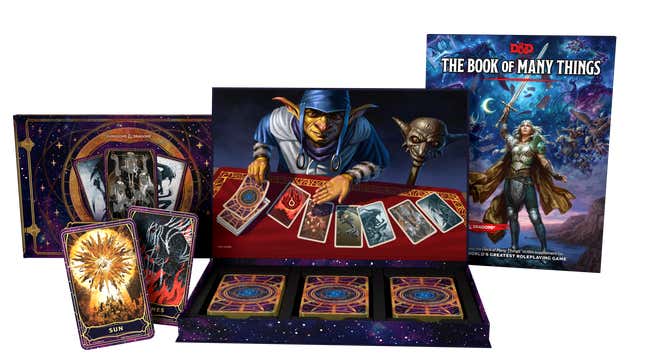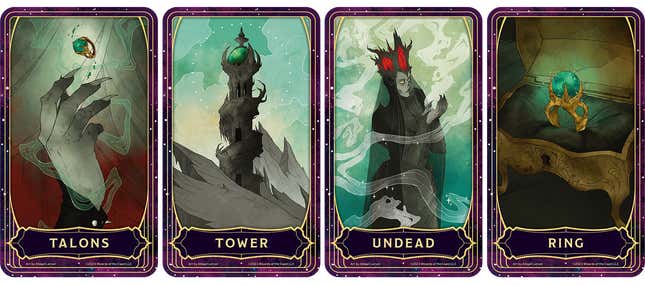In a press conference last week, Greg Tito, senior communications manager for Wizards of the Coast, discussed the upcoming Dungeons & Dragons product The Deck of Many Things alongside lead designer Jason Tondro and game designer Makenzie De Armas.
De Armas helped debut the deck at Gen Con, leading Dungeons & Dragons games using a nine-card spread from The Deck of Many Things to create a spontaneous adventure. Not necessarily tarot per se, The Deck of Many Things is more like an oracle deck—it comprises 66 cards, expanded from the original 22-card Deck of Many Things. The mechanical effects of the 44 new cards were designed by De Armas. The full set release includes the deck itself, The Book of Many Things, and an 80-page guidebook for the expanded deck. Right now there doesn’t appear to be any way to purchase anything individually, and the full package will cost $110.

Describing the release as “setting-agnostic,” Tondro called the Deck “an innovation project.” The deck itself doesn’t have suits; it’s much more similar to an oracle deck, but it has, broadly, four types of cards: characters, treasures, monsters, and landmarks. Each card is explained further in the guidebook, offering prompts and encouraging interpretation. The deck will encourage DMs to utilize “a wide variety of effects to suit all kinds of different gameplay,” said De Armas. She designed the 44 new cards “to fill in niches that the original deck of many things did not fill” by creating more options and opportunities within the prescribed interpretation of the cards to be more broadly applicable to various character builds.
“We wanted to make it easy to use,” said Tondro, “and only as chaotic as you want it to be.” The original Deck of Many Things magic item had a reputation for being a bit of a chaos creator in the original iteration. Both designers stressed that players would be able to build their own deck, and have outlined sample deck builds, such as the Deck of Horror, for campaigns with a more supernatural bent or in a darker setting like Ravenloft. Additionally, decks can be centered around artistic elements, mechanics, and even playstyle.
An example of artistic element threading can be seen below. The gold ring and its green gem features in all of the cards, and connections can be made throughout the four-card example of Talons (a classic from the original Deck of Many Things), Tower, Undead, and Ring.

The Deck of Many Things is also given a new celestial origin. “When we were first embarking on this project, we wanted to not only pay homage to the decks, many, many iterations and origins all throughout the history of D&D, but we also wanted to create a new origin story specifically for Fifth Edition,” explained De Armas. The book tells the story of how Istus—goddess of fate—used 12 star signs to create the first Deck of Many Things. Asteria and Uriel are two of the main characters of this book, and their story and stat blocks are written out in the last chapter of the Book of Many Things.
The Book of Many Things is a “toybox book,” much like Tasha’s Cauldron of Everything, that includes character items, magic items, adventure locations, puzzles, riddles, and traps, as well as the final fiction chapter that gives backstory to the book’s narrator, Asteria, and her sister Uriel. “Every chapter is designed to give you the tools you need to make the deck easier to use,” explained Tondro.
The book also included detailed explanations for oracle spreads that can be used to create campaigns with the cards—an experience that De Armas showcased at Gen Con. The adventure spread is clearly outlined, and uses some classic tarot conventions—crossing a past with an inciting incident, adding roadblocks and challenges—ultimately outlining a full story arc with nine cards. Todro explained playtesting this out, where three designers shuffled the same nine cards and could effectively create three different scenarios: “That’s when I knew that we had something, and that’s how we knew that it worked.”
The deck also comes with an 80-page hardcover guidebook showcasing each card. “It gives a person a place, a treasure, a monster, and a situation for every card. And then it also gives those same five for when the card is drawn in reverse—or upside down—so each card has 10 different interpretive meanings,” said Tondro.
The product looks great, but with a high price point and no obvious way to simply purchase the deck individually, it doesn’t seem to be aimed at new players in any way. This is an artifact product not for hardcore gamers, but for hardcore D&D fans.
But if you are a gamer who wants a gaming-inspired tarot deck, or even a game that uses tarot, there are dozens of options out there, like the very reasonably priced Ultimate RPG Tarot Deck, and the collector-aimed, Ennie-nominated Eldritch Overload Tarot. As for games, there’s the classic Spindlewheel (teaCabbage Studios), which uses a unique oracle deck, and also allows space for people to bring their favorite tarot decks to the table. Anamnesis (Sam Leigh), an award-winning solo journaling game, also uses tarot cards. You could also pick up Aurora (World Champ Game Co.) that encourages you to create your own oracle deck to suit the story.
Wizards of the Coast is jumping on a trend that indie games have been exploring for almost a decade, and it’s offering high production value, high prices, and a mass of tables that give you more and more and more options, creating a game that is so customizable that it’s almost a system agnostic supplement. But not quite.
The Deck of Many Things bundle will be available digitally October 31 and in game stores November 14.
Want more io9 news? Check out when to expect the latest Marvel, Star Wars, and Star Trek releases, what’s next for the DC Universe on film and TV, and everything you need to know about the future of Doctor Who.

